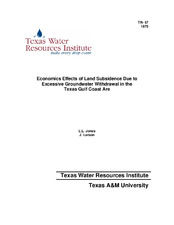| dc.description.abstract | Land surface subsidence continues to be a destructive force in the Texas Gulf Coast area. The sinking of the surface has been linked by engineers to the withdrawal of groundwater. Subsidence causes damages and property value losses as saltwater encroachment is increased, property is permanently inundated, and temporary flooding is intensified.
This study provides estimates of private and public costs attributable to land subsidence in a 945 square mile area that has subsided one foot or more since 1943. Estimates are divided into three sub-areas within this total area to provide insight into the incidence of subsidence-related costs. The sub-areas considered in this study were sub-area I, an 83 square mile area between Houston and Baytown containing square mile sample blocks adjacent to the upper Galveston bay and/or Buffalo Bayou and the Houston Ship Channel; sub-area II, the 25 square mile area surrounding Clear Lake and adjacent land fronting on Galveston bay; and sub-area III, the remaining area within the total 945 square mile area that had experienced subsidence of approximately two feet or more since 1943.
Personal interviews, using questionnaires designed for reporting of damages and property value losses by a random sample of owners of residential, commercial and industrial property, comprised the data base for estimating total private costs attributable to subsidence. Public costs (federal, state, county and municipal) were obtained from personal interviews with public officials. In total, over 1100 interviews were conducted in the study area. Data from these interviews were expanded to total cost estimates for the subsiding area.
Physical effects of surface subsidence were found to be largely dependent upon location of the property. Most damages and losses in property value occur in those areas in close proximity to Galveston bay and/or major waterways. Temporary flooding, permanent inundation, bulkheading and landfilling were the major subsidence-related causes of cost and/or losses in property value. Structural damages, largely from subsidence aggravated surface faults, were also significant. These comprised a higher proportion of damages in areas remote from the waterfront than in low lying areas subject to frequent flooding or permanent inundation.
Estimated annual costs and property value losses totaled over $31.7 million per year for the study area as a whole. These were primarily costs to residential, commercial and industrial property owners, but included over $.5 million per year in public costs for damage abatement or repair to public facilities.
Estimated costs by sub-areas revealed a higher incidence and intensity of damage and property value loss in waterfront (I and II) than in non-waterfront areas (III). Estimated costs in sub-areas I, II and III were $8.79 million, $5 million and $17.4 million, respectively. Sub-area I, which made up about 8.8 percent of the total study area, experienced 27.7 percent of total subsidence-related costs. Sub-area II experienced 15.8 percent of total costs while occupying only 3 percent of the total study area. And, although sub-area III had almost 55 percent of the total costs, it includes over 88 percent of the total area. Hence, subsidence damages and losses in property value are concentrated heavily in areas in close proximity to the immediate coastline of Galveston bay, Buffalo Bayou, Clear Lake and Taylor Lake. Other sections throughout the study area experienced damages and property losses but less frequently and less intensively.
A comparative analysis of the total costs of groundwater pumping with alternative surface water importation was developed to examine the economic feasibility of importing surface water to displace groundwater as a means of avoiding annual subsidence costs. A break-even analysis revealed that for the five year period 1969-73, the importation of surface water to meet all the area's water needs (up to 198.16 billion gallons per year) would have been economically justified from the standpoint of reducing total area water costs. | en |


